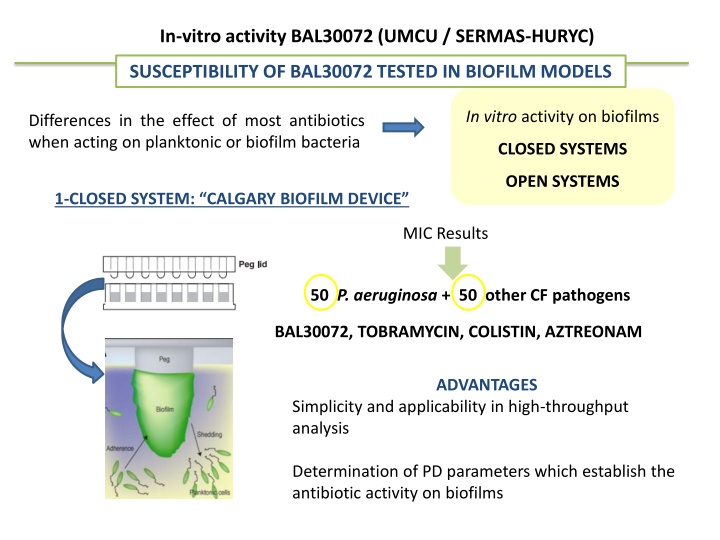
In-Vitro Activity of BAL30072 in Biofilm Models - Antibiotic Susceptibility Studies
Explore the in-vitro activity of BAL30072 in biofilm models, highlighting differences in antibiotic effects on planktonic vs. biofilm bacteria. Discover insights from closed and open system experiments, including MIC and BIC values of Tobramycin on CF pathogens. Learn about the advantages of Calgary Biofilm Device and Bioflux-Fluxion Biosciences for biofilm studies.
Download Presentation

Please find below an Image/Link to download the presentation.
The content on the website is provided AS IS for your information and personal use only. It may not be sold, licensed, or shared on other websites without obtaining consent from the author. If you encounter any issues during the download, it is possible that the publisher has removed the file from their server.
You are allowed to download the files provided on this website for personal or commercial use, subject to the condition that they are used lawfully. All files are the property of their respective owners.
The content on the website is provided AS IS for your information and personal use only. It may not be sold, licensed, or shared on other websites without obtaining consent from the author.
E N D
Presentation Transcript
In-vitro activity BAL30072 (UMCU / SERMAS-HURYC) SUSCEPTIBILITY OF BAL30072 TESTED IN BIOFILM MODELS In vitro activity on biofilms Differences in the effect of most antibiotics when acting on planktonic or biofilm bacteria CLOSED SYSTEMS OPEN SYSTEMS 1-CLOSED SYSTEM: CALGARY BIOFILM DEVICE MIC Results 50 P. aeruginosa + 50 other CF pathogens BAL30072, TOBRAMYCIN, COLISTIN, AZTREONAM ADVANTAGES Simplicity and applicability in high-throughput analysis Determination of PD parameters which establish the antibiotic activity on biofilms
In-vitro activity BAL30072 (UMCU / SERMAS-HURYC) SUSCEPTIBILITY OF BAL30072 TESTED IN BIOFILM MODELS 2-OPEN SYSTEM: BIOFLUX-FLUXION BIOSCIENCES Microfluidic channels Inlet wells Outlet wells ADVANTAGES Replicates the in vivo conditions Control of: - nutrient delivery - flow - temperature
In-vitro activity BAL30072 (UMCU / SERMAS-HURYC) SUSCEPTIBILITY OF BAL30072 TESTED IN BIOFILM MODELS EXPERIMENTS WITH TOBRAMYCIN- CF P. aeruginosa 6 P. aeruginosa (+ATCC 27853) strains from cystic fibrosis patients Diferent morphotypes (mucoid, smooth, small colony ) Chronic infection Primoinfection Tobramycin MICs: (susceptible) 0.5-4 mg/l Age (15-45 years old) Tobramycin BICs: 2-32 mg/l
In-vitro activity BAL30072 (UMCU / SERMAS-HURYC) EXPERIMENTS WITH TOBRAMYCIN- CF P. aeruginosa-BIOFLUX RESULTS Pab1 Pab2 Pab3 INOCULUM 24H TOBRAMYCIN MIC TOBRAMYCIN BIC ATCC 27853 Pab4 Pab5 Pab6 INOCULUM 24H TOBRAMYCIN MIC No biofilm formation TOBRAMYCIN BIC
In-vitro activity BAL30072 (UMCU / SERMAS-HURYC) SUSCEPTIBILITY OF BAL30072 TESTED IN BIOFILM MODELS BIOFLUX SOFTWARE INTENSITY OF COLOR-PIXELS ANALYSIS OF IMAGES = 255 = 0 VALUE = media of the intensity of the selected area in the microchanel % BIOFILM Mann Whitney test TOBRA MIC 0.0547 TOBRA BIC 0.0065 p<0.01
In-vitro activity BAL30072 (UMCU / SERMAS-HURYC) Coming next Calgary Biofilm activity of BAL30072, comparators Bioflux Fluorescence: dead/alive cells after antibiotic exposure Confocal images interspecies interactions Polymicrobial cultures Drugs alone and in combination
